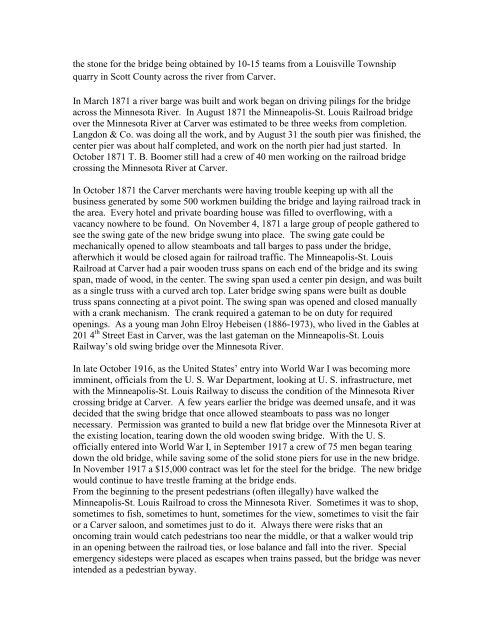Historic Homes and Businesses in Carver - Carver County Historical ...
Historic Homes and Businesses in Carver - Carver County Historical ...
Historic Homes and Businesses in Carver - Carver County Historical ...
You also want an ePaper? Increase the reach of your titles
YUMPU automatically turns print PDFs into web optimized ePapers that Google loves.
the stone for the bridge be<strong>in</strong>g obta<strong>in</strong>ed by 10-15 teams from a Louisville Township<br />
quarry <strong>in</strong> Scott <strong>County</strong> across the river from <strong>Carver</strong>.<br />
In March 1871 a river barge was built <strong>and</strong> work began on driv<strong>in</strong>g pil<strong>in</strong>gs for the bridge<br />
across the M<strong>in</strong>nesota River. In August 1871 the M<strong>in</strong>neapolis-St. Louis Railroad bridge<br />
over the M<strong>in</strong>nesota River at <strong>Carver</strong> was estimated to be three weeks from completion.<br />
Langdon & Co. was do<strong>in</strong>g all the work, <strong>and</strong> by August 31 the south pier was f<strong>in</strong>ished, the<br />
center pier was about half completed, <strong>and</strong> work on the north pier had just started. In<br />
October 1871 T. B. Boomer still had a crew of 40 men work<strong>in</strong>g on the railroad bridge<br />
cross<strong>in</strong>g the M<strong>in</strong>nesota River at <strong>Carver</strong>.<br />
In October 1871 the <strong>Carver</strong> merchants were hav<strong>in</strong>g trouble keep<strong>in</strong>g up with all the<br />
bus<strong>in</strong>ess generated by some 500 workmen build<strong>in</strong>g the bridge <strong>and</strong> lay<strong>in</strong>g railroad track <strong>in</strong><br />
the area. Every hotel <strong>and</strong> private board<strong>in</strong>g house was filled to overflow<strong>in</strong>g, with a<br />
vacancy nowhere to be found. On November 4, 1871 a large group of people gathered to<br />
see the sw<strong>in</strong>g gate of the new bridge swung <strong>in</strong>to place. The sw<strong>in</strong>g gate could be<br />
mechanically opened to allow steamboats <strong>and</strong> tall barges to pass under the bridge,<br />
afterwhich it would be closed aga<strong>in</strong> for railroad traffic. The M<strong>in</strong>neapolis-St. Louis<br />
Railroad at <strong>Carver</strong> had a pair wooden truss spans on each end of the bridge <strong>and</strong> its sw<strong>in</strong>g<br />
span, made of wood, <strong>in</strong> the center. The sw<strong>in</strong>g span used a center p<strong>in</strong> design, <strong>and</strong> was built<br />
as a s<strong>in</strong>gle truss with a curved arch top. Later bridge sw<strong>in</strong>g spans were built as double<br />
truss spans connect<strong>in</strong>g at a pivot po<strong>in</strong>t. The sw<strong>in</strong>g span was opened <strong>and</strong> closed manually<br />
with a crank mechanism. The crank required a gateman to be on duty for required<br />
open<strong>in</strong>gs. As a young man John Elroy Hebeisen (1886-1973), who lived <strong>in</strong> the Gables at<br />
201 4 th Street East <strong>in</strong> <strong>Carver</strong>, was the last gateman on the M<strong>in</strong>neapolis-St. Louis<br />
Railway‟s old sw<strong>in</strong>g bridge over the M<strong>in</strong>nesota River.<br />
In late October 1916, as the United States‟ entry <strong>in</strong>to World War I was becom<strong>in</strong>g more<br />
imm<strong>in</strong>ent, officials from the U. S. War Department, look<strong>in</strong>g at U. S. <strong>in</strong>frastructure, met<br />
with the M<strong>in</strong>neapolis-St. Louis Railway to discuss the condition of the M<strong>in</strong>nesota River<br />
cross<strong>in</strong>g bridge at <strong>Carver</strong>. A few years earlier the bridge was deemed unsafe, <strong>and</strong> it was<br />
decided that the sw<strong>in</strong>g bridge that once allowed steamboats to pass was no longer<br />
necessary. Permission was granted to build a new flat bridge over the M<strong>in</strong>nesota River at<br />
the exist<strong>in</strong>g location, tear<strong>in</strong>g down the old wooden sw<strong>in</strong>g bridge. With the U. S.<br />
officially entered <strong>in</strong>to World War I, <strong>in</strong> September 1917 a crew of 75 men began tear<strong>in</strong>g<br />
down the old bridge, while sav<strong>in</strong>g some of the solid stone piers for use <strong>in</strong> the new bridge.<br />
In November 1917 a $15,000 contract was let for the steel for the bridge. The new bridge<br />
would cont<strong>in</strong>ue to have trestle fram<strong>in</strong>g at the bridge ends.<br />
From the beg<strong>in</strong>n<strong>in</strong>g to the present pedestrians (often illegally) have walked the<br />
M<strong>in</strong>neapolis-St. Louis Railroad to cross the M<strong>in</strong>nesota River. Sometimes it was to shop,<br />
sometimes to fish, sometimes to hunt, sometimes for the view, sometimes to visit the fair<br />
or a <strong>Carver</strong> saloon, <strong>and</strong> sometimes just to do it. Always there were risks that an<br />
oncom<strong>in</strong>g tra<strong>in</strong> would catch pedestrians too near the middle, or that a walker would trip<br />
<strong>in</strong> an open<strong>in</strong>g between the railroad ties, or lose balance <strong>and</strong> fall <strong>in</strong>to the river. Special<br />
emergency sidesteps were placed as escapes when tra<strong>in</strong>s passed, but the bridge was never<br />
<strong>in</strong>tended as a pedestrian byway.


